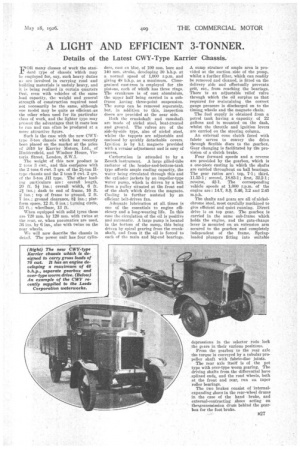A LIGHT AND EFFICIENT 3-TONNER,
Page 9

If you've noticed an error in this article please click here to report it so we can fix it.
Details of the Latest CWY-Type Karrier Chassis.
FOR many classes of work the standard type of chassis which may be. employed for, say, such heavy duties are involved in carrying road and building materials is unduly heavy, and it is being realised in certain quartets Olin. even with vehicles of the same load capacity, the weight and general strength of construction required need not necessarily be the same, although one model may be quite as efficient as the other when used for its particular class of work, and the lighter type may present the advantages that it costs less to run and can often be produced at a more attractive figure.
Such is the case with the new CWYtype 3-ton chassis which has recently been placed on the market at the price of .610 by Igarrier Motors, Ltd., of lItnidersfield, and Windsor House, Victoria Street, London, S.W.1.
The weight of this new product is 2 tons 3 cwt., and this con4Gares with the 2 tons,6 cwt. 3 qrs. of the 2i-ton IItype chassis and the 2 tons 9 cwt. 2 qrs. of the 3-tan JH type. The' other leading particulars are : overall length, 20 ft. 5f ins.; overall width, 6 ft. 2f ins.,; ,dash to end of frame, 16 ft. 2 ins.; tap of frame to ground, 2 ft. 7 ins. ; ground clearance,8f ins. ; platform space, 12 ft. 6 ins.; turning circle, 53 ft.; wheelbase, 13 ft.
When equipped with solid tyres these are 720 mm. by 120 mm. with twins at the rear, or, when pneumatics are used, 36 ins. by 6 ins., also with twins on the rear wheels.
We will now describe the chassis in detail. The power unit has four ders, cast en bloc, of 100 ram. bore and 140 mm. stroke, developing 30 b.la.p. at a normal speed of 1,000 r.p.m. and giving 48 bhp. as .a maximum. Chasegrained cast-iron is employed for the Pistons, each of ivhiCli has three rings. The crankcase is of cast aluminium, the upper half being carried in a subframe having three-point suspension. The sump can be removed separately, but, in addition to this, inspection doors are provided at the near side.
.11oth the crankshaft and camshaft are 'made of nickel steel, beat-treated and ground, The valves are of the side-by-side type, also of nickel steel, whilst the tappets are adjustable and enclosed by quickly detachable covers. Ignition is by h.t. magneto provided with a vernier adjustment and is easy of access.
Carburation is attended to by a Zenith instrument. A large gilled-tube radiator of the header-and-bottom-tank type affords ample cooling capacity, the water being circulated through this and the cylinder jackets by an impeller-type water pump, which is driven by a belt from a pulley 8ituated at the front end of the shaft which drives the magneto. Cooling is further assisted by an efficient belt-driven fan.
Adequate lubrication at alltimes is One of the essentials to engine efficiency and a long-wearing life. In this case the circulation of the oil is positive and automatic. A large pump is located in the bottom of the sump, this being driven by spiral gearing from the crankshaft, and from it the oil is forced to each of the main and big-end bearings,
A sump strainer of ample area is provided at the suction side of the pump, whilst a further filter, which can readily be removed and cleaned, is fitted on the delivery side and effectually prevents grit, etc., from reaching the hearings. There is an adjustable relief valve through which the oil surplus to that required for maintaining the correct gauge pressure is discharged on to the timing, wheels and the magneto chain.
The fuel supply is obtained from a petrol tank having a capacity, of 22 gallons and is mounted on the dash, whilst the throttle and ignition levers -are carried on the steering column.
An external Cone clutch faced with fabric serves to convey the drive through flexible discs to the gearbox. Gear changing is facilitated by the provision of a clutch brake.
Four forward speeds and a reverse are provided by the gearbox, which is a one-piece casting in which the shafts are carried throughout on .ball bearings. The gear ratios are: top, 7-1; third, 11.55-1; second, 18.834 ; first, 32.2-1; reverse, 42-1. The corresponding vehicle speeds at 1,000 r.p.m. of the engine art: 14.7,8.9, 5.46, 3.2 and 2.45
The shafts and gears are all of nickelchrome steel, most carefully machined to give efficient and quiet running. Direct drive is on top gear. The gearbox is carried in the same sub-frame which holds the engine, and the gate-change lever is mounted on an extension arm secured to the gearbox and completely independent of the frame. Springloaded plungers fitting into suitable depressions in the selector rods lock the gears in their various positiams.
From the gearbox to the rear axle the torque is conveyed by a tubular propeller shaft with fabric-disc joints.
The rear axle itself is of the pot type with over-type worm gearing. The driving shafts from the differential have .splined ends, and the road wheels, both at the front and rear, run on taper roller bearings.
The two brakes consist of internalexpanding shoes in the rear-wheel drums in the case of -the hand brake, and external-contracting shoes acting on theuransmission drum behind the gearbox for the foot brake.


























